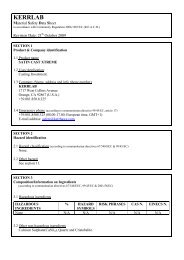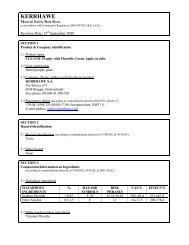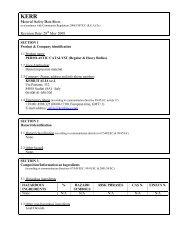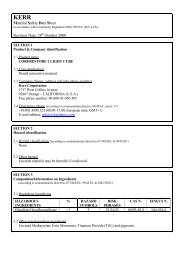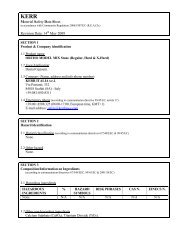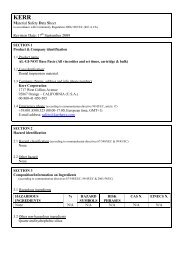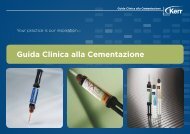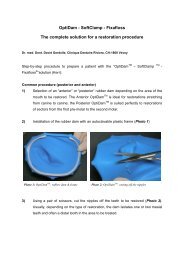6W[P)VUK XTR - Kerrdental.co.uk
6W[P)VUK XTR - Kerrdental.co.uk
6W[P)VUK XTR - Kerrdental.co.uk
Create successful ePaper yourself
Turn your PDF publications into a flip-book with our unique Google optimized e-Paper software.
Instructions for Use<br />
DIRECT RESTORATIONS<br />
Bonding Composites/Compomers to Dentin/Enamel<br />
1. Prepare cavity. Pumice clean unprepared tooth structure with a fluoridefree<br />
cleaning paste; rinse thoroughly with water spray and air dry.<br />
2. Apply PRIMER to the enamel/dentin surface using the disposable applicator<br />
brush. Scrub the surface with a brushing motion for 20 se<strong>co</strong>nds.<br />
3. Air thin for 5 se<strong>co</strong>nds with medium air pressure.<br />
4. Shake ADHESIVE bottle briefly. Apply ADHESIVE to the enamel/dentin<br />
surface with light brushing motion for 15 se<strong>co</strong>nds.<br />
5. Air thin for 5 se<strong>co</strong>nds.<br />
6. Light cure for 10 se<strong>co</strong>nds*.<br />
7. Apply <strong>co</strong>mposite ac<strong>co</strong>rding to manufacturer’s instructions for use.<br />
INDIRECT RESTORATIONS<br />
I. Restoration Surface Preparation<br />
Prepare the internal surface of the restoration ac<strong>co</strong>rding to manufacturer’s<br />
instructions. Here are some general re<strong>co</strong>mmendations:<br />
Ceramic/Porcelain Restorations: Sandblast the surface with<br />
50µ alumina with a pressure of about 30 psi (0.2 MPa) and etch the<br />
restoration with hydrofluoric acid for 1 minute. Apply a <strong>co</strong>at of Kerr silane<br />
on the internal surface of the restoration, and lightly air thin. Protect the<br />
restorations from light as Kerr silane <strong>co</strong>ntains resin and is light-sensitive.<br />
Metal-based, Zir<strong>co</strong>nia-based, Alumina-based, and Composite<br />
Restorations: Sandblast the internal surface with 50µ alumina with a<br />
pressure of about 60 psi (0.4 MPa) for metal-based, zir<strong>co</strong>nia-based and<br />
alumina-based restorations, or a pressure of about 15 psi (0.1 MPa) for<br />
<strong>co</strong>mposite restorations. Apply a <strong>co</strong>at of OptiBond <strong>XTR</strong> ADHESIVE on the<br />
internal surface of the restoration, air thin with gentle air first and then<br />
strong air to avoid pooling of adhesive, and light-cure for 10 se<strong>co</strong>nds*(lightcuring<br />
of adhesive is optional if NX3 resin cement is used for cementation).<br />
II. Tooth Surface Preparation<br />
1. Clean the preparation. Wash thoroughly with water spray and air dry.<br />
2. Apply PRIMER to the enamel/dentin surface using the disposable applicator<br />
brush. Scrub the surface with a brushing motion for 20 se<strong>co</strong>nds.<br />
3. Air thin for 5 se<strong>co</strong>nds with medium air pressure.<br />
4. Shake ADHESIVE bottle briefly. Apply ADHESIVE to the enamel/dentin<br />
surface with light brushing motion for 15 se<strong>co</strong>nds.<br />
5. Air thin with gentle air first and then strong air for at least 5 se<strong>co</strong>nds to avoid<br />
pooling of adhesive before light curing. For post cementation, excess adhesive<br />
can be removed with a dry applicator brush or absorbent paper point.<br />
6. Light cure for 10 se<strong>co</strong>nds*.<br />
III. Cement Application and Seating of Restoration<br />
See indication-specific information in sections A-C below. Veneers, crowns,<br />
bridges, inlays, onlays and metal-based restorations (used in <strong>co</strong>njunction<br />
with a luting cement)<br />
Note: OptiBond <strong>XTR</strong> is <strong>co</strong>mpatible with all self-cure and dual-cure<br />
resin cement or <strong>co</strong>re buildup material.<br />
4



